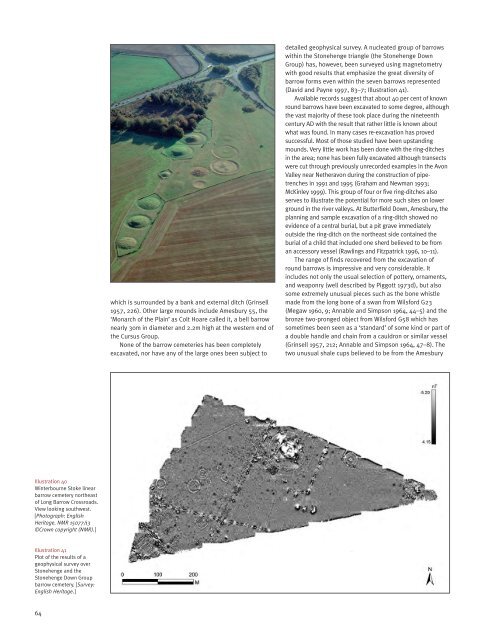stonehenge - English Heritage
stonehenge - English Heritage
stonehenge - English Heritage
You also want an ePaper? Increase the reach of your titles
YUMPU automatically turns print PDFs into web optimized ePapers that Google loves.
047-120 section 2.qxd 6/21/05 4:18 PM Page 64<br />
which is surrounded by a bank and external ditch (Grinsell<br />
1957, 226). Other large mounds include Amesbury 55, the<br />
‘Monarch of the Plain’ as Colt Hoare called it, a bell barrow<br />
nearly 30m in diameter and 2.2m high at the western end of<br />
the Cursus Group.<br />
None of the barrow cemeteries has been completely<br />
excavated, nor have any of the large ones been subject to<br />
detailed geophysical survey. A nucleated group of barrows<br />
within the Stonehenge triangle (the Stonehenge Down<br />
Group) has, however, been surveyed using magnetometry<br />
with good results that emphasize the great diversity of<br />
barrow forms even within the seven barrows represented<br />
(David and Payne 1997, 83–7; Illustration 41).<br />
Available records suggest that about 40 per cent of known<br />
round barrows have been excavated to some degree, although<br />
the vast majority of these took place during the nineteenth<br />
century AD with the result that rather little is known about<br />
what was found. In many cases re-excavation has proved<br />
successful. Most of those studied have been upstanding<br />
mounds. Very little work has been done with the ring-ditches<br />
in the area; none has been fully excavated although transects<br />
were cut through previously unrecorded examples in the Avon<br />
Valley near Netheravon during the construction of pipetrenches<br />
in 1991 and 1995 (Graham and Newman 1993;<br />
McKinley 1999). This group of four or five ring-ditches also<br />
serves to illustrate the potential for more such sites on lower<br />
ground in the river valleys. At Butterfield Down, Amesbury, the<br />
planning and sample excavation of a ring-ditch showed no<br />
evidence of a central burial, but a pit grave immediately<br />
outside the ring-ditch on the northeast side contained the<br />
burial of a child that included one sherd believed to be from<br />
an accessory vessel (Rawlings and Fitzpatrick 1996, 10–11).<br />
The range of finds recovered from the excavation of<br />
round barrows is impressive and very considerable. It<br />
includes not only the usual selection of pottery, ornaments,<br />
and weaponry (well described by Piggott 1973d), but also<br />
some extremely unusual pieces such as the bone whistle<br />
made from the long bone of a swan from Wilsford G23<br />
(Megaw 1960, 9; Annable and Simpson 1964, 44–5) and the<br />
bronze two-pronged object from Wilsford G58 which has<br />
sometimes been seen as a ‘standard’ of some kind or part of<br />
a double handle and chain from a cauldron or similar vessel<br />
(Grinsell 1957, 212; Annable and Simpson 1964, 47–8). The<br />
two unusual shale cups believed to be from the Amesbury<br />
Illustration 40<br />
Winterbourne Stoke linear<br />
barrow cemetery northeast<br />
of Long Barrow Crossroads.<br />
View looking southwest.<br />
[Photograph: <strong>English</strong><br />
<strong>Heritage</strong>. NMR 15077/13<br />
©Crown copyright (NMR).]<br />
Illustration 41<br />
Plot of the results of a<br />
geophysical survey over<br />
Stonehenge and the<br />
Stonehenge Down Group<br />
barrow cemetery. [Survey:<br />
<strong>English</strong> <strong>Heritage</strong>.]<br />
64

















